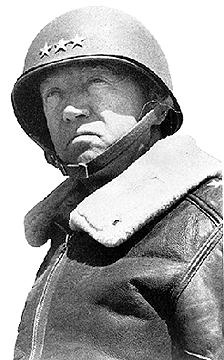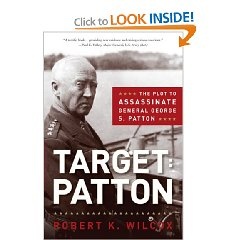 George S. Patton, America’s greatest combat general of the Second World War, was assassinated after the conflict with the connivance of US leaders, according to a new book.
George S. Patton, America’s greatest combat general of the Second World War, was assassinated after the conflict with the connivance of US leaders, according to a new book.
By Tim Shipman
‘We’ve got a terrible situation with this great patriot, he’s out of control and we must save him from himself’. The OSS head General did not trust Patton The newly unearthed diaries of a colourful assassin for the wartime Office of Strategic Services (OSS), the forerunner of the CIA, reveal that American spy chiefs wanted Patton dead because he was threatening to expose allied collusion with the Russians that cost American lives.
The death of General Patton in December 1945, is one of the enduring mysteries of the war era. Although he had suffered serious injuries in a car crash in Manheim, he was thought to be recovering and was on the verge of flying home. But after a decade-long investigation, military historian Robert Wilcox claims that OSS head General "Wild Bill" Donovan ordered a highly decorated marksman called Douglas Bazata to silence Patton, who gloried in the nickname "Old Blood and Guts".
His book, "Target Patton", contains interviews with Mr Bazata, who died in 1999, and extracts from his diaries, detailing how he staged the car crash by getting a troop truck to plough into Patton’s Cadillac and then shot the general with a low-velocity projectile, which broke his neck while his fellow passengers escaped without a scratch.
Mr Bazata also suggested that when Patton began to recover from his injuries, US officials turned a blind eye as agents of the NKVD, the forerunner of the KGB, poisoned the general.
Mr Wilcox told The Sunday Telegraph that when he spoke to Mr Bazata: "He was struggling with himself, all these killings he had done. He confessed to me that he had caused the accident, that he was ordered to do so by Wild Bill Donovan.
"Donovan told him: ‘We’ve got a terrible situation with this great patriot, he’s out of control and we must save him from himself and from ruining everything the allies have done.’ I believe Douglas Bazata. He’s a sterling guy."
Mr Bazata led an extraordinary life. He was a member of the Jedburghs, the elite unit who parachuted into France to help organise the Resistance in the run up to D-Day in 1944. He earned four purple hearts, a Distinguished Service Cross and the French Croix de Guerre three times over for his efforts.
After the war he became a celebrated artist who enjoyed the patronage of Princess Grace of Monaco and the Duke and Duchess of Windsor.
He was friends with Salvador Dali, who painted a portrait of Bazata as Don Quixote.
He ended his career as an aide to President Ronald Reagan’s Navy Secretary John Lehman, a member of the 9/11 Commission and adviser to John McCain’s presidential campaign.
 Mr Wilcox also tracked down and interviewed Stephen Skubik, an officer in the Counter-Intelligence Corps of the US Army, who said he learnt that Patton was on Stalin’s death list. Skubik repeatedly alerted Donovan, who simply had him sent back to the US.
Mr Wilcox also tracked down and interviewed Stephen Skubik, an officer in the Counter-Intelligence Corps of the US Army, who said he learnt that Patton was on Stalin’s death list. Skubik repeatedly alerted Donovan, who simply had him sent back to the US.
"You have two strong witnesses here," Mr Wilcox said. "The evidence is that the Russians finished the job."
The scenario sounds far fetched but Mr Wilcox has assembled a compelling case that US officials had something to hide. At least five documents relating to the car accident have been removed from US archives.
The driver of the truck was whisked away to London before he could be questioned and no autopsy was performed on Patton’s body.
With the help of a Cadillac expert from Detroit, Mr Wilcox has proved that the car on display in the Patton museum at Fort Knox is not the one Patton was driving.
"That is a cover-up," Mr Wilcox said.
George Patton, a dynamic controversialist who wore pearl handled revolvers on each hip and was the subject of an Oscar winning film starring George C. Scott, commanded the US 3rd Army, which cut a swathe through France after D-Day.
But his ambition to get to Berlin before Soviet forces was thwarted by supreme allied commander Dwight D. Eisenhower, who gave Patton’s petrol supplies to the more cautious British General Bernard Montgomery.
Patton, who distrusted the Russians, believed Eisenhower wrongly prevented him closing the so-called Falaise Gap in the autumn of 1944, allowing hundreds of thousands of German troops to escape to fight again,. This led to the deaths of thousands of Americans during their winter counter-offensive that became known as the Battle of the Bulge.
In order to placate Stalin, the 3rd Army was also ordered to a halt as it reached the German border and was prevented from seizing either Berlin or Prague, moves that could have prevented Soviet domination of Eastern Europe after the war.
Mr Wilcox told The Sunday Telegraph: "Patton was going to resign from the Army. He wanted to go to war with the Russians. The administration thought he was nuts.
"He also knew secrets of the war which would have ruined careers.
I don’t think Dwight Eisenhower would ever have been elected president if Patton had lived to say the things he wanted to say." Mr Wilcox added: "I think there’s enough evidence here that if I were to go to a grand jury I could probably get an indictment, but perhaps not a conviction."
Charles Province, President of the George S. Patton Historical Society, said he hopes the book will lead to definitive proof of the plot being uncovered. He said: "There were a lot of people who were pretty damn glad that Patton died. He was going to really open the door on a lot of things that they screwed up over there."
REVIEW
From the Inside Flap
He was the most controversial American general in World War II–and also one of the most successful, courageous, and audacious. As a post-war administrator of defeated Germany, he sounded alarm bells about the dangers of Soviet encroachment into Europe. Politically, he was a lightning rod–an outspoken conservative who continually embarrassed his superiors with his uncensored, undiplomatic, and unrestrained comments to the press. He was General George S. Patton Jr., old Blood and Guts.In 1945, shortly before he was to fly home to the states as a conquering hero, he was involved in a mysterious car crash that left him partially paralyzed.
Two weeks later, just as his doctors were about to send him home to finish his recovery, he was dead.The army ruled the car crash an accident, his death natural. Yet witness testimony on the crash conflicted, key players in the incident disappeared, official reports vanished, soldiers were ordered to keep silent, and there was no autopsy performed on the body.
Investigative and military reporter Robert Wilcox, author of Black Aces High and Wings of Fury, has spent more than ten years investigating these mysteries, and in Target: Patton he has written an electrifying account of the shocking circumstances–long hidden from the public–surrounding the death of America’s most famous general. In Target: Patton, you’ll discover:* The extraordinary war hero, artist, and mercenary who said he was ordered by U.S. intelligence to assassinate Patton
* The OSS agent who knew Patton was in danger and tried to save him
* New evidence from recently declassified documents revealing doubts about the official version of Patton’s death
* The final stories of those involved in the accident, including those who were thought to have disappeared–until now
Provocative, shocking, and compelling, Target: Patton takes you through the maze of denials, contradictions, and treacheries behind one of the great unsolved mysteries of World War II.
ATTENTION READERS
We See The World From All Sides and Want YOU To Be Fully InformedIn fact, intentional disinformation is a disgraceful scourge in media today. So to assuage any possible errant incorrect information posted herein, we strongly encourage you to seek corroboration from other non-VT sources before forming an educated opinion.
About VT - Policies & Disclosures - Comment Policy



